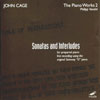Cage Sonatas and Interludes for Prepared Piano
View record and artist detailsRecord and Artist Details
Composer or Director: John Cage
Label: Mode Records
Magazine Review Date: 2/1997
Media Format: CD or Download
Media Runtime: 64
Mastering:
DDD
Catalogue Number: MODE50

Tracks:
| Composition | Artist Credit |
|---|---|
| Sonatas and Interludes |
John Cage, Composer
John Cage, Composer Philipp Vandré, Piano |
Author: Peter Dickinson
Cage’s Sonatas and Interludes are often referred to as a masterpiece and, by now, it ought to be easy to see why. Completed in 1948, the set was first performed and recorded by Maro Ajemian (Dial LP), although Cage did play it himself. When Nigel Butterley’s performance was released on Tall Poppies in 1994, I preferred it to Fremy on Etcetera. The difference in this new release with Vandre is that he was told by Ivar Mikhashoff, who had it from Cage, that the Sonatas and Interludes had originally been written for a Steinway Model ‘O’ baby grand. Since Cage’s preparations are designed to be placed at a measured distance from the end of the string, the sound will be lower on a smaller piano. You can test this out by comparing Vandre and Butterley in the last Sonata. Butterley’s low notes early on are simply a dead thud, but Vandre produces a sonorous gong. In the Thirteenth Sonata, one of Cage’s most ingratiating melodies, Vandre produces a lovely poetic effect. But Butterley even misses some of the melody notes, which cannot have been Cage’s intention.
There is a minor problem in the Fourth Sonata, where Vandre plays a B as the third note. The score is a reproduction of Cage’s clear but occasionally idiosyncratic manuscript and I have always read this ambiguous third note as an A, which it is in the immediate repeat. Ajemian played an A; so did Butterley; but Vandre plays a B, which I regret. I suppose Cage might have enjoyed this situation, but this is not an indeterminate work although the preparations produce varied results between performances.
In 1994 I complained that both Butterley and Fremy were not strict enough about Cage’s note-values. Vandre puts this right, although his tempos are on the meditative side. He is always slower than Butterley, who frequently exceeds Cage’s markings. Overall Vandre’s case for the Steinway ‘O’ is extremely convincing and resolves problems about the preparations; his is a sensitive and musical performance – now unhesitatingly first choice.'
There is a minor problem in the Fourth Sonata, where Vandre plays a B as the third note. The score is a reproduction of Cage’s clear but occasionally idiosyncratic manuscript and I have always read this ambiguous third note as an A, which it is in the immediate repeat. Ajemian played an A; so did Butterley; but Vandre plays a B, which I regret. I suppose Cage might have enjoyed this situation, but this is not an indeterminate work although the preparations produce varied results between performances.
In 1994 I complained that both Butterley and Fremy were not strict enough about Cage’s note-values. Vandre puts this right, although his tempos are on the meditative side. He is always slower than Butterley, who frequently exceeds Cage’s markings. Overall Vandre’s case for the Steinway ‘O’ is extremely convincing and resolves problems about the preparations; his is a sensitive and musical performance – now unhesitatingly first choice.'
Discover the world's largest classical music catalogue with Presto Music.

Gramophone Digital Club
- Digital Edition
- Digital Archive
- Reviews Database
- Full website access
From £8.75 / month
Subscribe
Gramophone Full Club
- Print Edition
- Digital Edition
- Digital Archive
- Reviews Database
- Full website access
From £11.00 / month
Subscribe
If you are a library, university or other organisation that would be interested in an institutional subscription to Gramophone please click here for further information.




